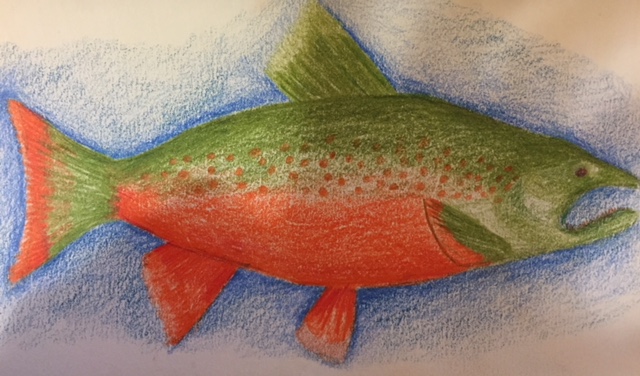The next time I walk up to the seafood counter in any grocery store, I am going to pause and listen to the stories of those fish displayed behind the glass. I imagine closing my eyes and returning to Iceland’s Þingvellir National Park where I stood on a bridge overlooking the moving bodies of beautiful brown trout. I imagine stepping back into the Aquaculture farm I recently visited to peer into the great circular tanks of Arctic Char. In feeling the wind on my cheeks again, I will recall all that I have learned about these creatures. Now I would love to share some of this information and insight with you.

An astounding 1/2 billion pounds of seafood is taken from the ocean each day (Seafood Watch, 2014). Many wild fish species are declining which has prompted the spread of Aquaculture systems where fish are raised in indoor and outdoor tanks. While some systems are designed to reduce environmental impact, many of them use various chemicals and dispose of large amounts of waste. There are currently over two million tons of trout and salmon raised in the world, mainly through cage farming which uses chemicals and drugs to deal with disease and parasites (Motorka, 2013). I learned from my instructor that globally Aquaculture supplies more than 50% of the seafood within the United States at 5-7% and China as the top contributor. These statistics seem all the more relevant after visiting an Aquaculture farm firsthand. The operation raises Arctic Char which is a cold water fish related to salmon and trout and is a good choice in part due to less disease and habitat impact. For example, this farm has been able to get their conversion ratio down to 1.3kg of feed to 1kg of fish which is quite good, especially compared with other animal proteins like chickens at 2:1 and cows at 6:1. I learned that the feed contains corn, wheat and soy along with other ingredients whereas the wild Arctic Char eat salmon eggs, snails and crustaceans. I discovered that there is another Aquaculture farm near Reykjavík called Matorka that is working on cultivating algae for feeding their fish, making sure not to use any antibiotics, chemicals or genetically modified ingredients. This just shows me that there are businesses out there that are asking the question, “how do we raise fish sustainably?”
When I dream of a sustainable system I think of using less electricity, avoiding chemicals, feeding fish more natural and sustainable food sources, making the fish waste into compost to grow food and recycling water. Imagining what is possible opens the opportunity to make small changes. I believe that the key is to see the fish for who they are and care about them as if they were family. To me this means letting go of self-interest to be in full service of the fish and their environment. Lately I have been thinking a lot about how much I give and take within my relationship to life. How do I feel when I purchase vegetables at the store compared with planting a seed in my garden? I feel more empowered when I act as a caregiver of the earth and live as an engaged student and author of sustainability. Instead of trying to control a system and make it work, I think it is necessary for me to see myself as responsible and part of it. I intend to keep looking closely at what is around me and diving into subjects I know nothing about. I recently learned that mussels are one of the best seafood options in my home state of Maine in part because of their role in cleaning the water as filter feeders. However I also want to keep in mind that there is a decline in blue mussel populations within Maine so careful measures need to be taken. Seafood Watch where I found information about mussels is a great source if you want to find out about sustainable seafood options in your area. I am aware that there is so much to discover and I want to keep learning…and dreaming…and acting.
Teagan Wu
References:
Matorka Sustainable Food (2013). Product Development/Innovation
Seafood Watch: “Make Better Seafood Choices.” online video clip. Youtube. 6 Feb 2014.Seafood Watch
Towers, Lucy. (2016). “Sustainable Arctic Char Farming to Expand Following Investment.” The Fish Site. The Fish Site
